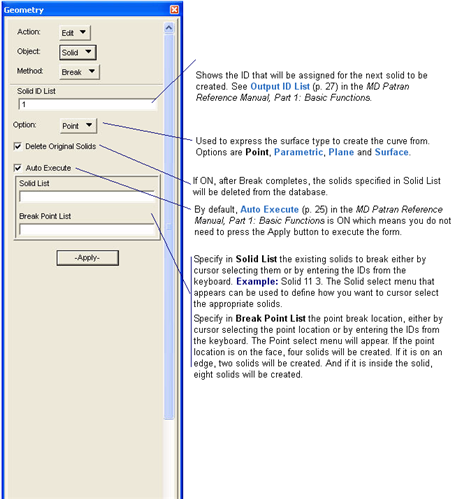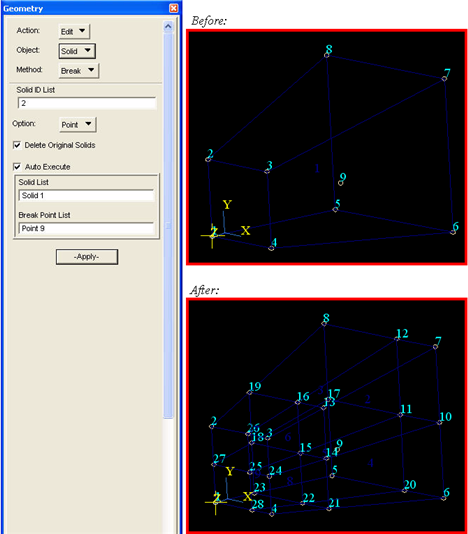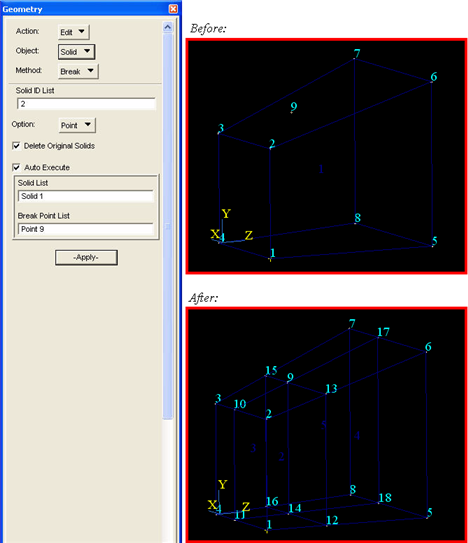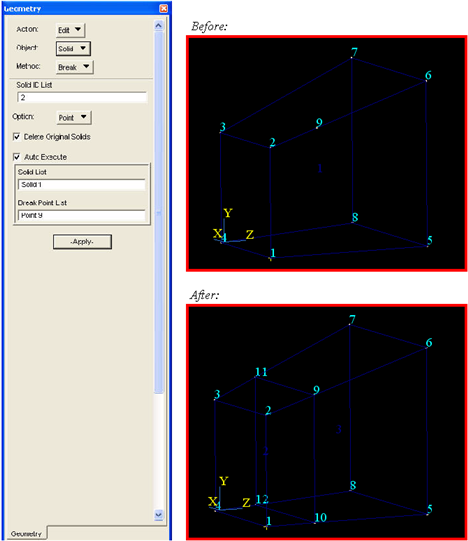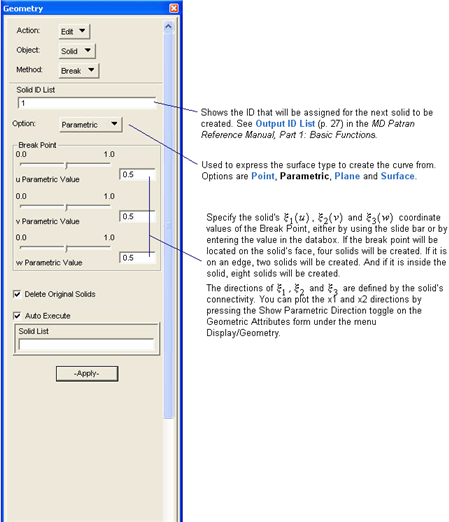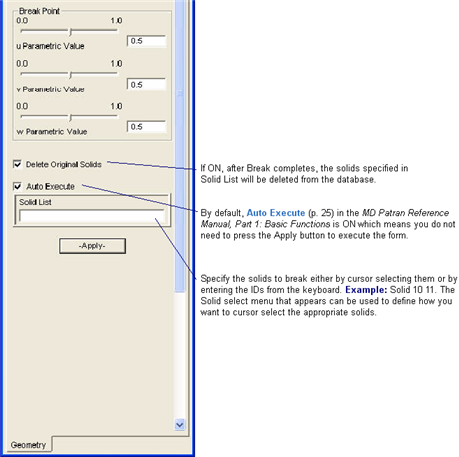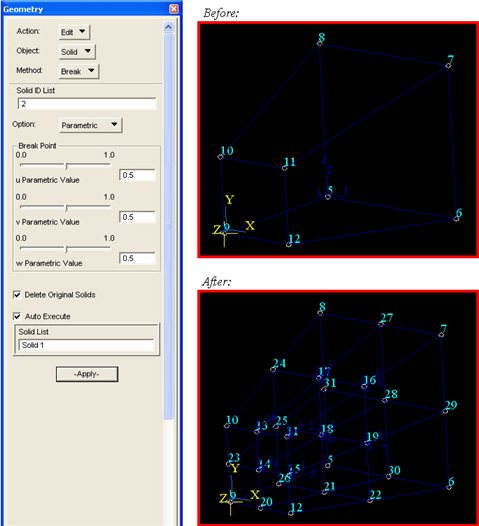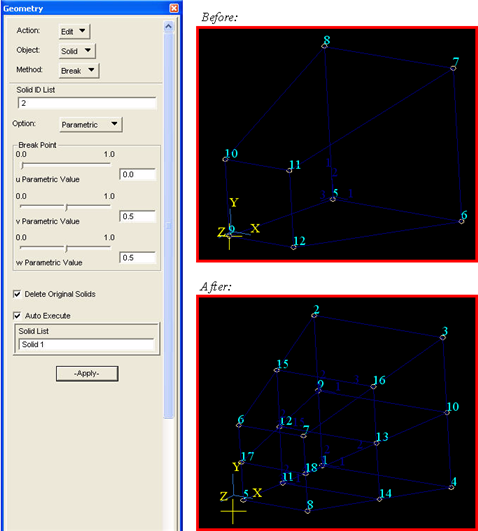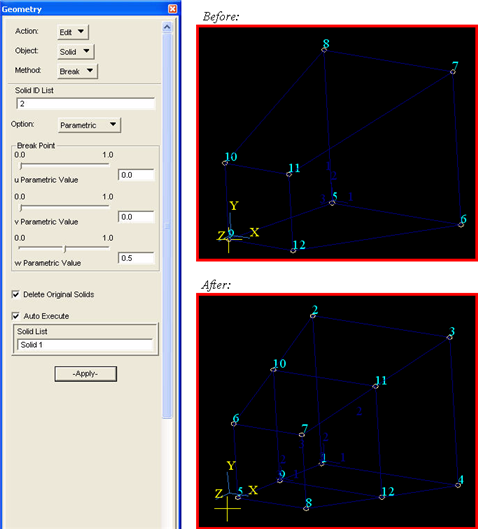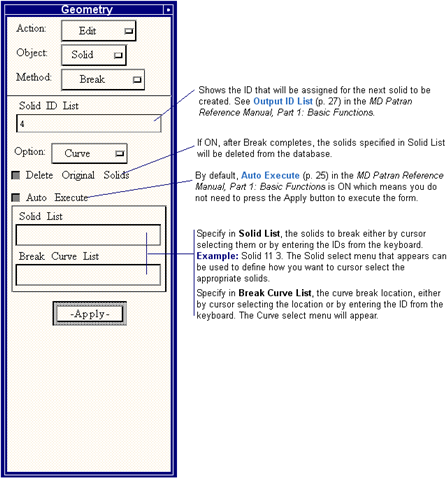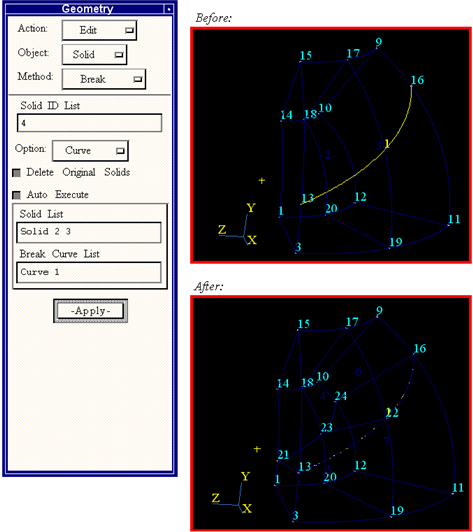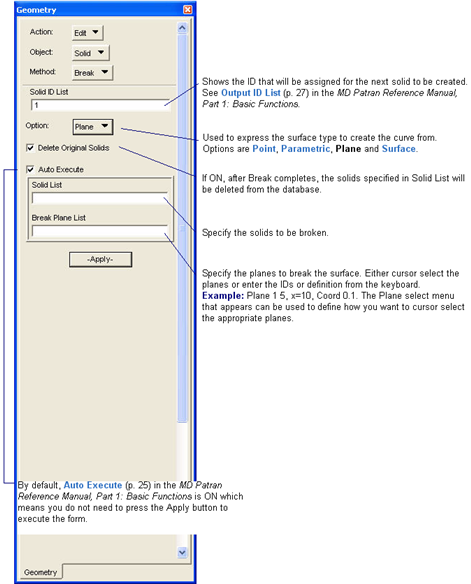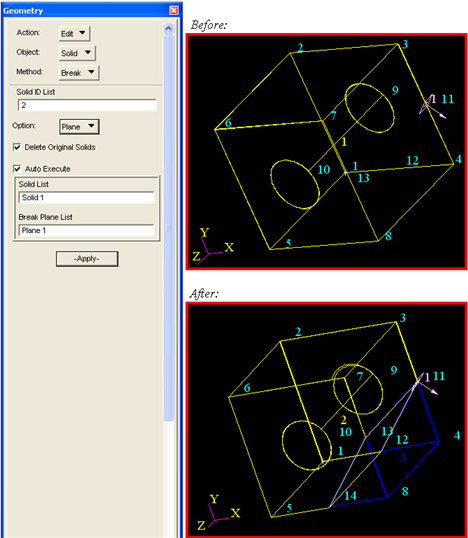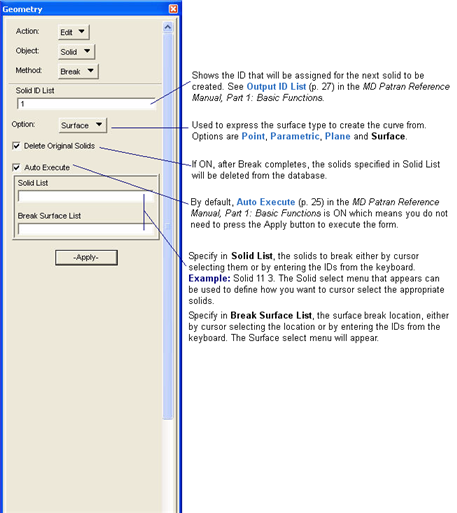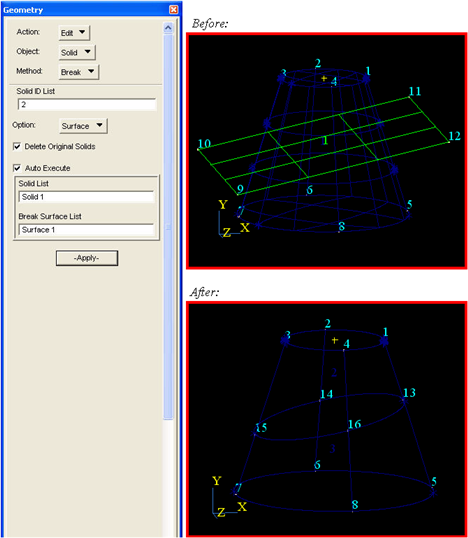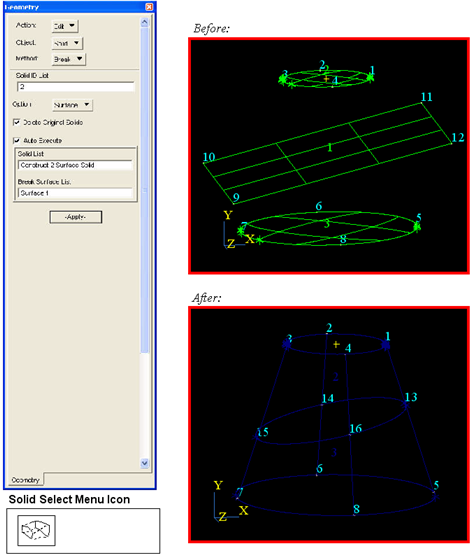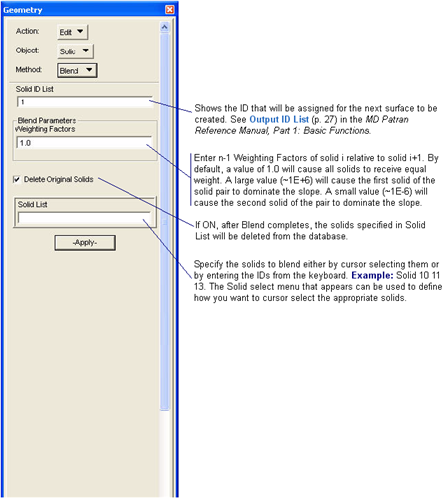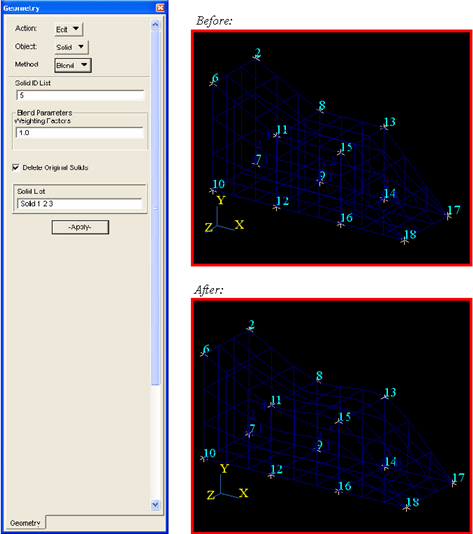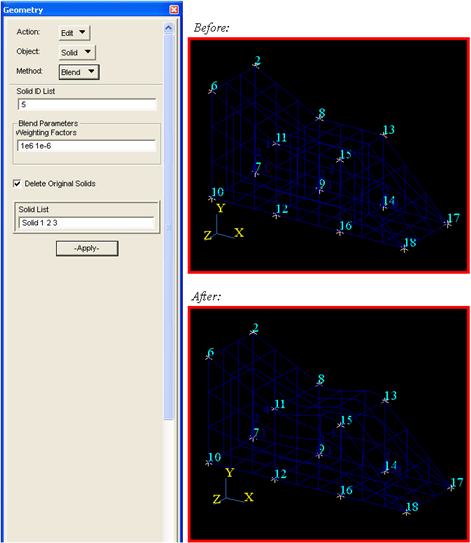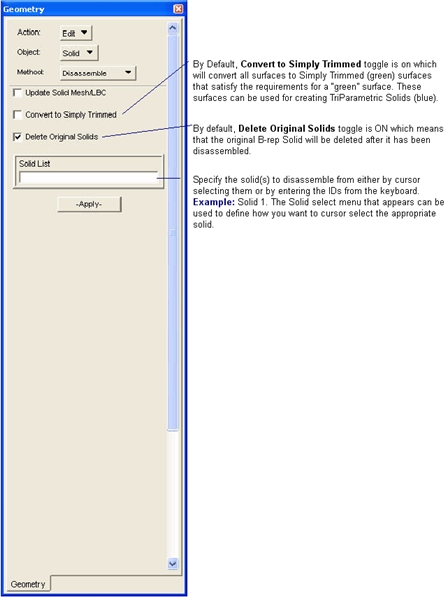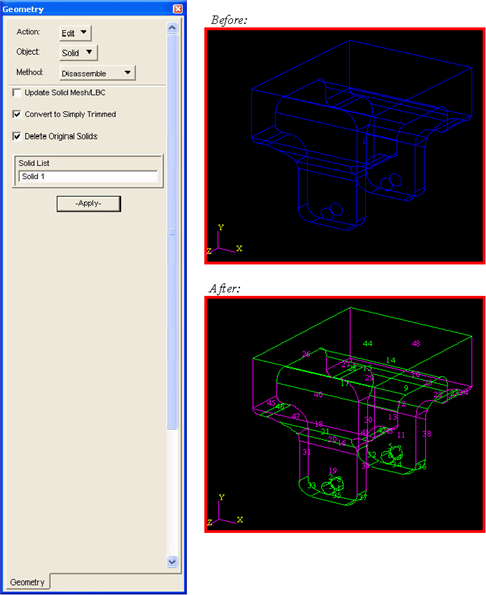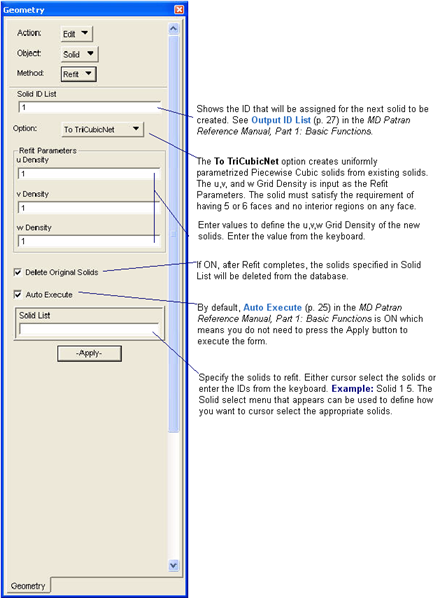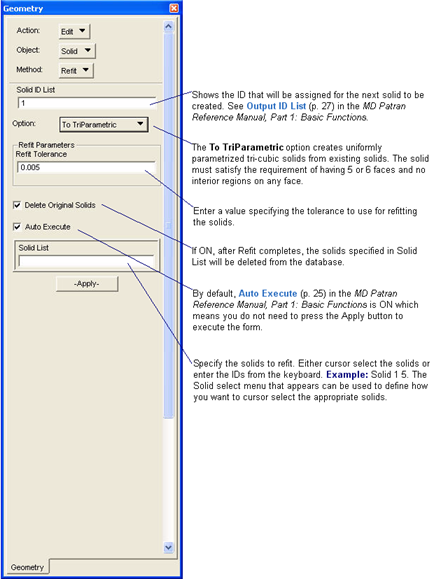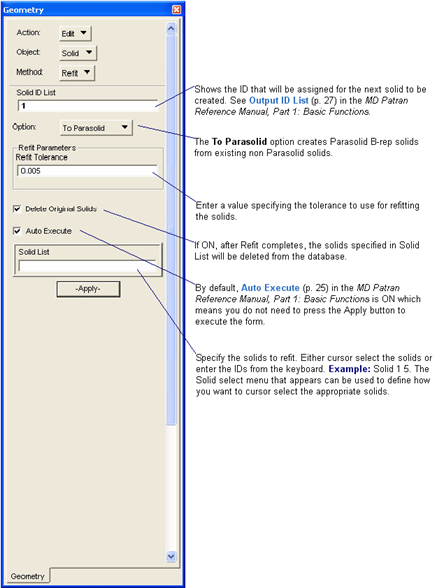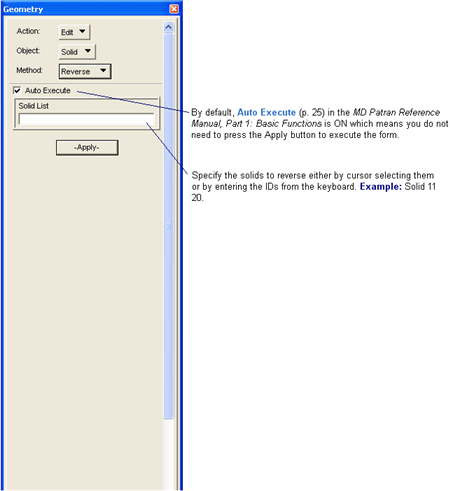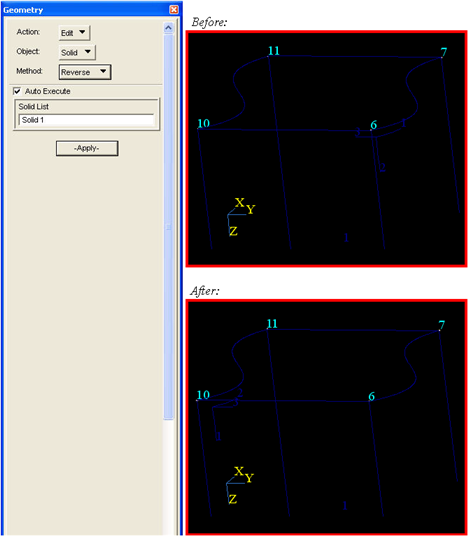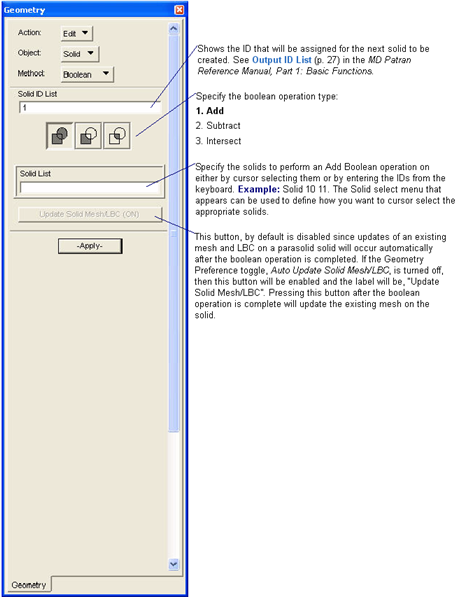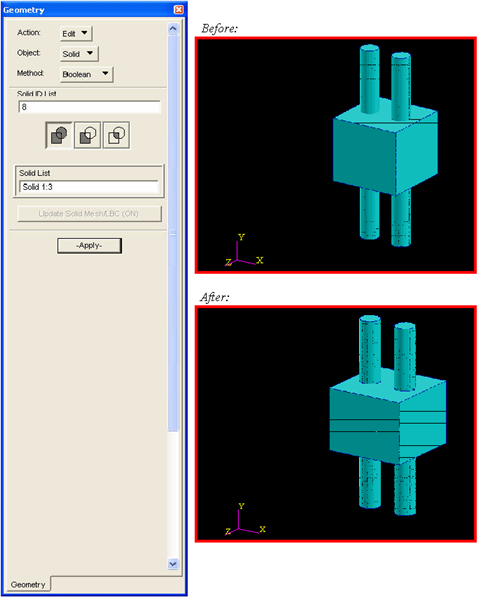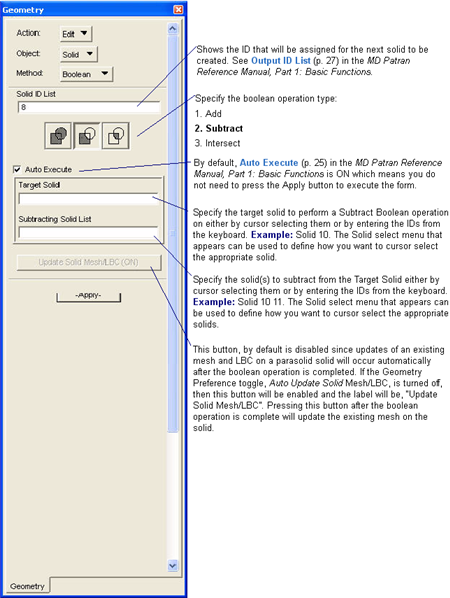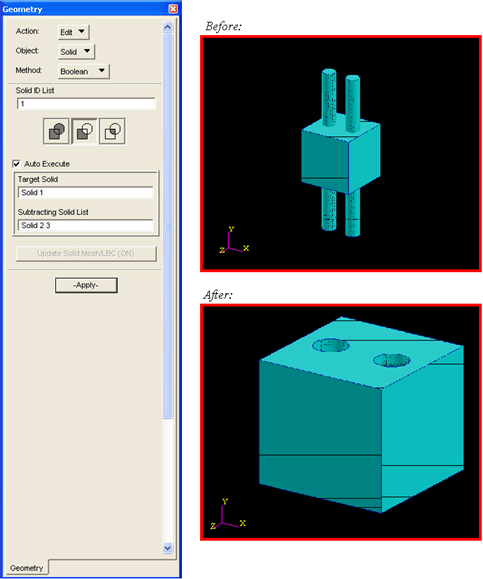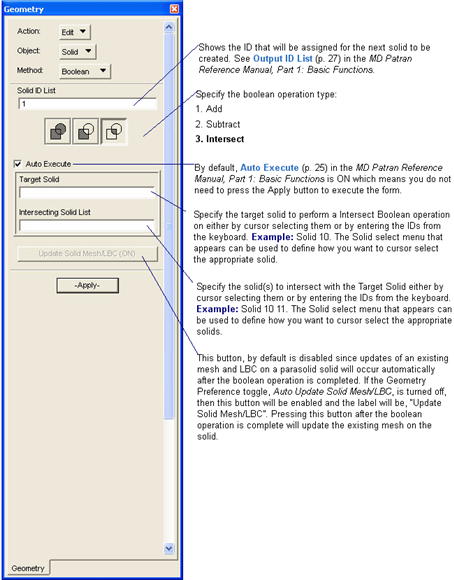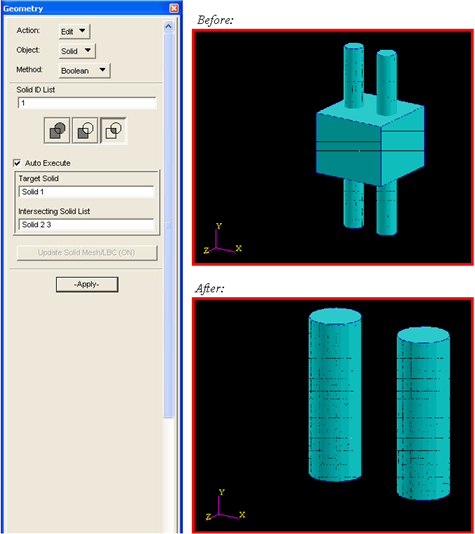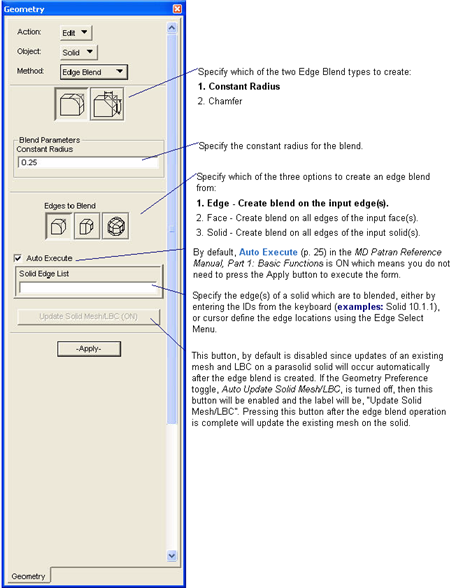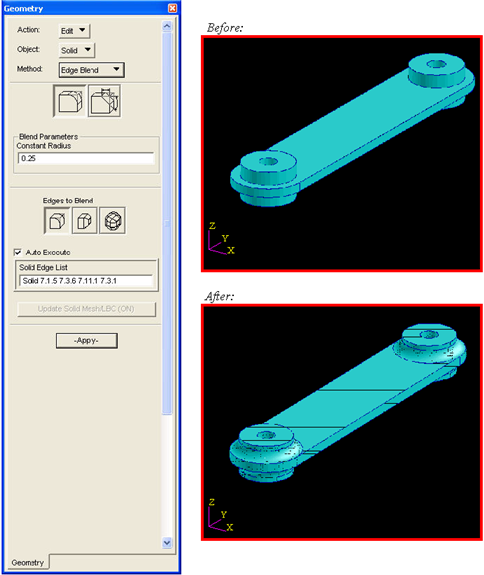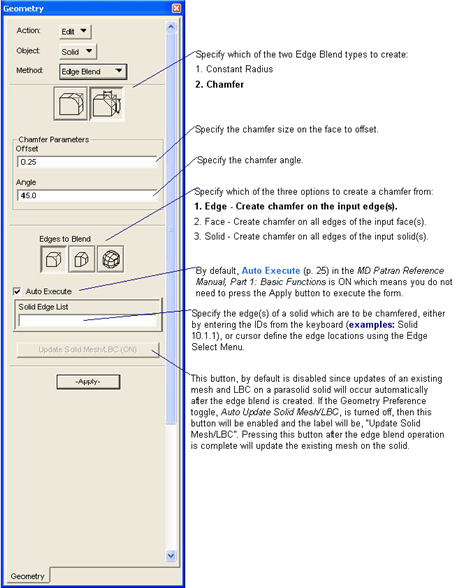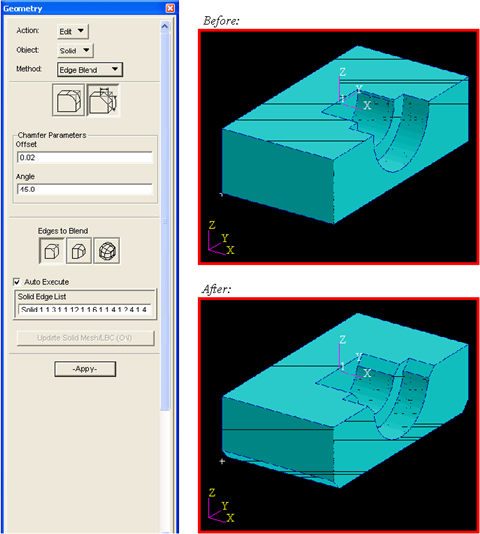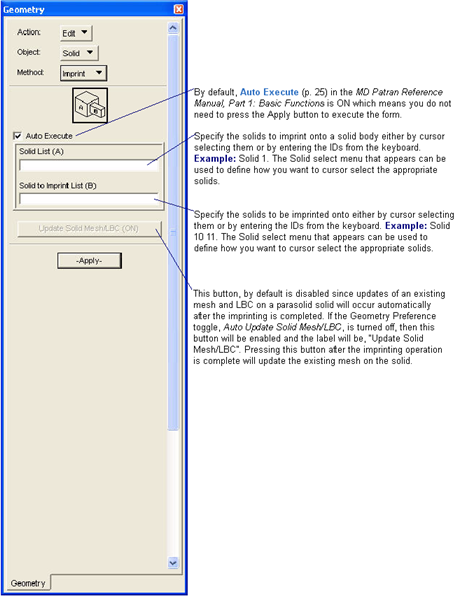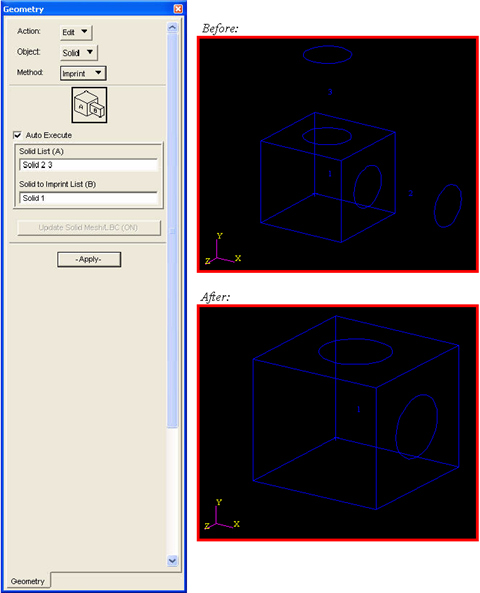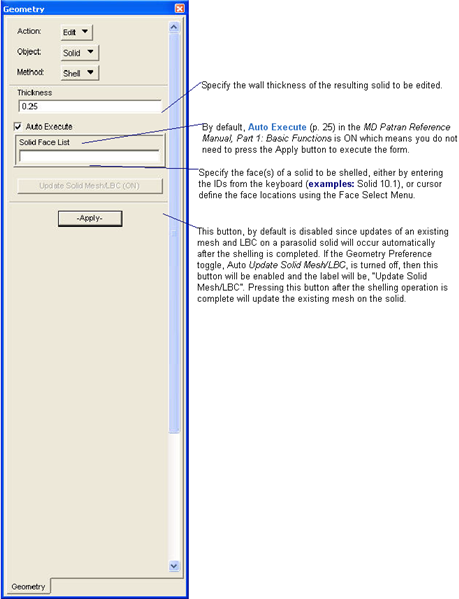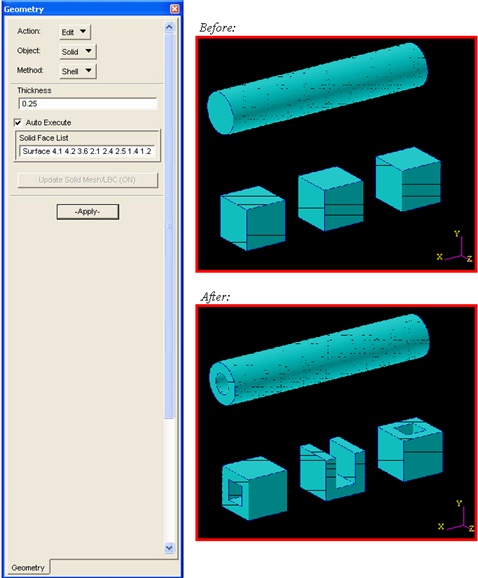XXXXXXXXXXXXXXXXXXXXXXXXXXXXXXXXXXXXXXXXXXXXXXXXXXXXXXXXXXXXXXXXXXXXXXXXXXXXXXXXXXXXXXXXXXXXXXXXXXXXXXXXXXXXXXXXXXXXXXXXXXXXXXXXXXXXXXXXXXXXXXXXXXXXXXXX''"> Editing Solids
Breaking Solids
Breaking Solids with the Point Option
The Break method with the Point option breaks an existing solid into two or four smaller solids at a point location. The point location can be on or within the solid.
More Help:
Solid Break Method with the Point Option Example
Breaks Solid 1 into eight solids by referencing Point 9. Notice that Delete Original Surfaces is pressed and Solid 1 is deleted.
Solid Break Method with the Point Option Example
This example is similar to the previous example, except that the break point is on a face instead of inside of Solid 1, and four solids are created instead of eight.
Solid Break Method with the Point Option Example
This example is similar to the previous example, except that the break point is on an edge instead of on a face of Solid 1, and two solids are created instead of four.
Breaking Solids with the Parametric Option
The Break method with the Parametric option creates two, four or eight solids from an existing solid. The break location is defined at the solid’s parametric

,

, and

coordinate locations where

has a range of
 ,
, 
has a range of

and

has a range of

.
Tip: More Help:
Solid Break Method with the Parametric Option Example
Breaks Solid 1 into eight smaller solids at

,

, and

. Notice that Delete Original Surfaces is pressed and Surface 1 is deleted and that the parametric direction is displayed.
Solid Break Method with the Parametric Option Example
This example is similar to the previous example, except

instead of

, and Surface 1 is broken into four solids instead of eight.
Solid Break Method with the Parametric Option Example
This example is similar to the first example, except

and

instead of

and

, and Surface 1 is broken into two solids instead of eight.
Breaking Solids with the Curve Option
The Break method with the Curve option breaks an existing solid into two solids at a curve break location. The curve location must completely lie on and bisect a face of the solid.
Tip: More Help:
Solid Break Method with the Curve Option Example
Breaks Solids 2 and 3 into two solids each at Curve 1. Notice that Delete Original Solids is pressed and Solid 1 is deleted.
Breaking Solids with the Plane Option
The method breaks a solid with a plane. The solid will be broken along its intersection with the plane.
Tip: More Help:
Breaking a Solid with the Plane Option Example
Creates Solids 2 and 3 by breaking Solid 1 along its intersection with Plane 1. Notice that Delete Original Solids is pressed and Solid 1 is deleted.
Breaking Solids with the Surface Option
The Break method with the Surface option breaks an existing solid into two smaller solids at a surface break location. The surface break location must completely pass through the solid.
Tip: More Help:
Solid Break Method with the Surface Option Example
Breaks Solid 1 into two solids at Surface 1. Notice that Delete Original Solids is pressed and Solid 1 is deleted.
Solid Break Method with the Surface Option Between Two Surfaces Example
This example is the same as the previous example, except that the solid is defined by Surfaces 2 and 3 by using the Solid select menu icon listed below.
Blending Solids
The Blend method creates a set of parametric tri-cubic solids from an existing set of two or more solids, such that the first derivative continuity is maintained across the surface boundaries between adjacent solids. The existing solids can have any parametrization, but they must share common faces.
Tip: More Help:
Solid Blend Method Example
Creates Solids 4, 5 and 6 by blending Solids 1, 2 and 3. Notice that Delete Original Solids is pressed and Solids 1, 2 and 3 are deleted.
Solid Blend Method Example
This example is similar to the previous example, except that weighting factors, 1e6 and 1e-6, are used so that Solids 1 and 3 dominate the slope.
Disassembling B-rep Solids
The Disassemble method operates on one or more boundary represented (B-rep) solids and breaks them into the original surfaces that composed each B-rep solid. A B-rep solid can be created by the Geometry Application’s Create/Solid/B-rep form.
Tip: More Help:
Disassemble a B-rep Solid Example
Disassemble solid 1 into its constituent surfaces and convert all possible surfaces into Simply Trimmed surfaces (green). If “Conver to Simply Trimmed” toggle was OFF, the resulting surfaces would maintain their original type; (magenta).
Refitting Solids
Refitting Solids with the To TriCubicNet Option
This form is used to refit a solid to alternative mathematical solid representations. The form provides three Options; To TriCubicNet, To TriParametric, and To Parasolid.
Tip: More Help:
Refitting Solids with the To TriParametric Option
This form is used to refit a solid to alternative mathematical solid representations. The form provides three Options; To TriCubicNet, To TriParametric, and To Parasolid.
Tip: More Help:
Refitting Solids with the To Parasolid Option
This form is used to refit a solid to alternative mathematical solid representations. The form provides three Options; To TriCubicNet, To TriParametric, and To Parasolid.
Tip: More Help:
Reversing Solids
The Reverse method redefines the connectivity of an existing set of solids by exchanging the positive

and

directions of the solids. Then, to maintain a positive parametric frame, Patran translates the parametric origin up the original

axis and then reverses the

direction. You can plot the
 ,
, 
and

directions for the solids by pressing the Show Parametric Direction toggle on the Geometric Attributes form found under the menu Display/Geometry.
Solid Reverse Method Example
Reverses the parametric directions for Solid 1 (only the top half of Solid 1 is shown). Notice that the parametric origin is relocated.
Solid Boolean Operation Add
This form is used to perform a Solid boolean of “Add”.
Tip: More Help:
Solid Boolean Operation Add Example
Add Solids 2 and 3 to Solid 1.
Solid Boolean Operation Subtract
This form is used to perform a Solid boolean operation of “Subtract”.
Tip: More Help:
Solid Boolean Operation Subtract Example
Subtract solids 2 and 3 from solid 1.
Solid Boolean Operation Intersect
This form is used to perform a Solid boolean operation of “Intersect”.
Tip: More Help:
Solid Boolean Operation Intersect Example
Intersect solids 2 and 3 with solid
Creating Solid Edge Blends
Creating Constant Radius Edge Blends from Solid Edges
This form is used to create a constant radius edge blend on an edge(s) of a solid.
Tip: More Help:
Creating Constant Radius Edge Blend from Solid Edges Example
Create an Edge Blend of Radius 0.25 on Solid 7 edges Solid 7.1.5 7.3.6 7.11.1 and 7.3.1.
Creating Chamfer Edge Blend from Solid Edges
This form is used to create a constant angle chamfer on an edge(s) of a solid.
Tip: More Help:
Creating Chamfer Edge Blend from Solid Edges Example
Create Chamfers with offset of 0.02 and angle of 45 degrees on Solid 1 edges Solid 1.1.3 1.1.12 1.1.6 1.1.4 1.2.4 and 1.4.4.
Imprinting Solid on Solid
This form is used to imprint solid bodies on solid bodies.
Tip: More Help:
Imprint Solid on Solid Example
Imprint Solid Cylinders 2 and 3 onto the faces of Solid Block 1. The Cylinders have been deleted to show the results of the imprint.
Solid Shell Operation
This form is used to create a void in a solid by shelling the selected faces.
Tip: More Help:
Solid Shell Operation Example
Shell solids 1t4 with a wall thickness=0.25 using faces solid 4.1 4.2 3.6 2.1 2.4 2.5 1.4 and 1.2.
